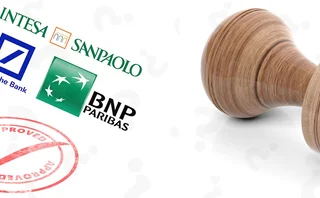
Hong Kong may front-run China TLAC requirements
Chinese G-Sibs could be forced to issue in Hong Kong before group TLAC requirements apply

The largest Chinese banks may be forced to issue bail-in debt under Hong Kong’s new resolution framework imminently, even though the Financial Stability Board (FSB) has given China an additional six years to comply with the global total loss absorbing capacity (TLAC) framework.
“Loss absorbing capacity requirements can be applied to any authorised institution incorporated in Hong Kong, regardless of whether their foreign parent’s jurisdiction has a resolution regime or not,” says a spokesperson for the Hong Kong Monetary Authority (HKMA).
The majority of the world’s global systemically important banks (G-Sibs) must comply with TLAC requirements from 2019, and have already begun issuing bail-in debt. However, the FSB gave emerging market G-Sibs – currently only the four largest banks in China – up to an extra six years to comply.
These four banks are unable to issue TLAC-eligible debt until the China Banking Regulatory Commission (CBRC) puts forwards its framework for this, but Hong Kong issued a consultation paper on internal LAC requirements for the locally systemic subsidiaries of G-Sibs in January.
“There is a disconnect,” says Simon Topping, a partner at KPMG. “How can you introduce an internal LAC framework for Chinese banks when there is nothing that can effectively trickle down?”
Under recommendations in the January consultation paper issued by the HKMA, subsidiaries of banks that have a materially significant presence in Hong Kong will have to make a certain proportion of the TLAC debt they have issued at group level available domestically, so it can be converted to equity in cases where the subsidiary becomes non-viable.
But there is no equivalent TLAC regime as yet in China, making it difficult for the HKMA to defer to home rules for subsidiaries of the Chinese banks falling under its jurisdiction.
The HKMA recommends setting internal LAC at between 75% and 90% of the external TLAC requirement that would apply to the sub-group if it were a resolution group, depending on “institution-specific circumstances”. This is in line with the FSB standards finalised in November 2015.
However, the consultation paper provides few clues as to how it plans to deal with subsidiaries of banks that have not issued TLAC at group level, prompting one banking analyst to remark: “How can the HKMA produce a consultation paper of 92 pages, which doesn’t point out that the second-biggest bank in Hong Kong isn’t actually going to issue any TLAC?”
It is a very different matter in Hong Kong… those banks that have already issued TLAC at the group level are directly competing with Chinese banks in the domestic market, and if you treat them differently you will create an uneven playing field
Simon Topping, KPMG
Two of the six banks designated by the HKMA as domestic systemically important banks (D-Sibs) are Chinese G-Sibs: the Bank of China, and the Industrial and Commercial Bank of China. Although China Construction Bank (CCB) has not yet been classed as a D-Sib, it has the third-largest pool of assets of any bank in Hong Kong – after HSBC and Bank of China – and could still be subjected to the new local LAC framework.
Topping says there are two approaches the HKMA could decide to take. One would be to defer to the group regulation authority – in this case the CBRC – and allow Chinese banks to apply LAC on a consolidated basis, which would effectively give the domestic subsidiaries the same six-year transition period currently enjoyed by the group entity. However, this would almost certainly put the non-Chinese G-Sibs operating in Hong Kong at a significant disadvantage until 2025.
“Although the FSB have given this transition period at G-Sib level, this doesn’t really affect the [international] competitive environment, because in reality the Chinese G-Sibs are largely domestic anyway,” says Topping. “It is a very different matter in Hong Kong though, because those banks that have already issued TLAC at the group level are directly competing with Chinese banks in the domestic market, and if you treat them differently you will create an uneven playing field.”
Second option
The second possibility would be for the HKMA to force the large Chinese banks it supervises to issue TLAC, irrespective of the home-country regulation.
Royce Miller, a partner at Freshfields law firm, based in Hong Kong, thinks the second approach has clear advantages since it keeps the HKMA, which is a key financial hub for most G-Sibs, in line with international standards.
“The HKMA doesn’t want to detract from Hong Kong as a financial centre, and they have been good at applying international rules and standards in the past, except where there is a particular reason to do something different,” says Miller. “The regulator is not going to hardwire something into the new LAC framework that limits its power to act locally in the future if it needs to.”
However, Miller also recognises the challenges the HKMA will face in imposing requirements on Chinese banks that are materially different from the ones they face at home. “Will they really want to front-run regulations?” he asks.
Closed-door discussions
The HKMA spokesperson hints at another channel at its disposal for managing the recovery and resolution process of Chinese banks: closed-door discussions with home regulators.
“For [institutions] subject to the proposed LAC rules who have foreign parent entities, [the HKMA’s] preference in the first instance will always be to develop a co-ordinated cross-border resolution strategy in co-operation with the foreign home authority,” says the spokesperson.
This is how the HKMA works with other regulators, such as the Financial Conduct Authority in the UK. Sonny Hsu, an analyst at Moody’s, says this may be why the HKMA is comfortable with the Hong Kong resolution entities of HSBC and Standard Chartered holding relatively low levels of external TLAC.
“The HKMA could also work closely with the CBRC to work out the best way for Chinese banks to be regulated, and how much capital and LAC they should be required to hold,” says Hsu.
Although Chinese authorities have not yet given any indication as to when they might introduce a TLAC framework, market participants speculate new rules could be forthcoming later this year – if regulators are to give banks enough time to issue all of the TLAC-eligible debt they will need by the 2025 deadline.
HKMA’s consultation closes on March 16 and the regulator plans to reveal new TLAC rules by the end of the year.
Only users who have a paid subscription or are part of a corporate subscription are able to print or copy content.
To access these options, along with all other subscription benefits, please contact info@risk.net or view our subscription options here: http://subscriptions.risk.net/subscribe
You are currently unable to print this content. Please contact info@risk.net to find out more.
You are currently unable to copy this content. Please contact info@risk.net to find out more.
Copyright Infopro Digital Limited. All rights reserved.
You may share this content using our article tools. Printing this content is for the sole use of the Authorised User (named subscriber), as outlined in our terms and conditions - https://www.infopro-insight.com/terms-conditions/insight-subscriptions/
If you would like to purchase additional rights please email info@risk.net
Copyright Infopro Digital Limited. All rights reserved.
You may share this content using our article tools. Copying this content is for the sole use of the Authorised User (named subscriber), as outlined in our terms and conditions - https://www.infopro-insight.com/terms-conditions/insight-subscriptions/
If you would like to purchase additional rights please email info@risk.net
More on Regulation
Risk, portfolio margin, regulation: regtech to the rescue
A white paper outlining the complexity of setting the course for risk, margin and regulation
Prop shops recoil from EU’s ‘ill-fitting’ capital regime
Large proprietary trading firms complain they are subject to hand-me-down rules originally designed for banks
Revealed: the three EU banks applying for IMA approval
BNP Paribas, Deutsche Bank and Intesa Sanpaolo ask ECB to use internal models for FRTB
FCA presses UK non-banks to put their affairs in order
Greater scrutiny of wind-down plans by regulator could alter capital and liquidity requirements
Industry calls for major rethink of Basel III rules
Isda AGM: Divergence on implementation suggests rules could be flawed, bankers say
Saudi Arabia poised to become clean netting jurisdiction
Isda AGM: Netting regulation awaiting final approvals from regulators
Japanese megabanks shun internal models as FRTB bites
Isda AGM: All in-scope banks opt for standardised approach to market risk; Nomura eyes IMA in 2025
CFTC chair backs easing of G-Sib surcharge in Basel endgame
Isda AGM: Fed’s proposed surcharge changes could hike client clearing cost by 80%







